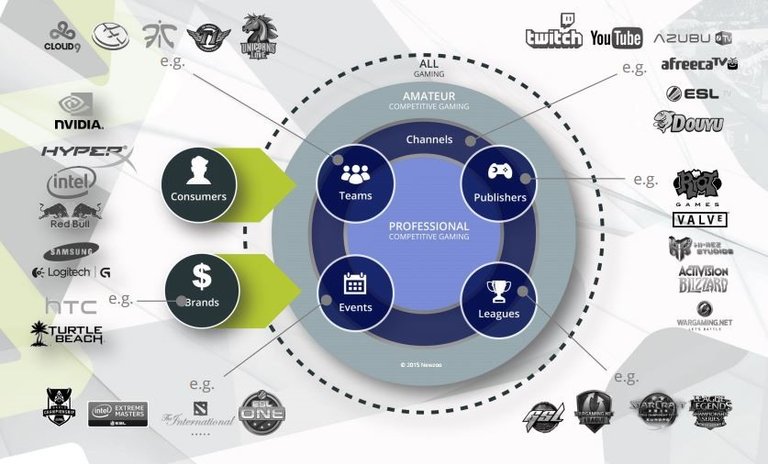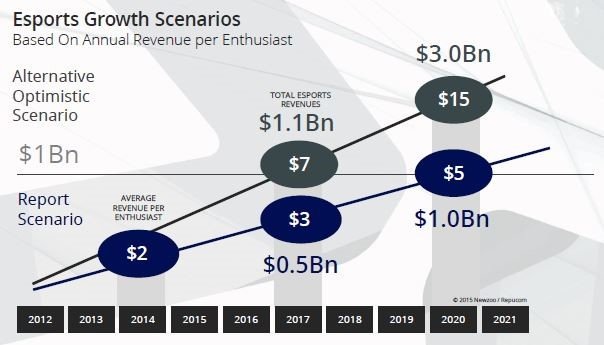
Anyone entering the market with aims of joining a growing industry may consider eSports as a viable option. There is a full spectrum of employment options that include software development, consumer marketing, and large-scale event planning (some of which are curated online or through virtual reality). With a myriad of business opportunities and an expanding media presence, the potential in eSports to vest startup equity shares or climb ranks of established companies is vast.
For players, comparable to athletes of other sports, eSports doesn’t involve much more movement than rapid keystrokes or mouse clicks. Despite the seemingly limited attraction of physical athleticism, live events are viewed by more consumers (23.5 million) than both the MLB World Series and NBA Finals (ESPN, 2016). Revenues expect to approach $500 million in the coming years (Deloitte, 2016), and this new “sport” has firmly planted itself as a subcategory in the broader sports industry. Even ESPN has begun making adjustments to the rise of this new market activity.
What are eSports?
Electronic sports (eSports) include real-time strategy, virtual fighting, first-person shooting experiences, and multiplayer online strategy. The sport involves active communication, seemingly constant recalibrations, and meticulous hand-eye coordination, which makes for a unique, albeit subtle, set of skills. Organized online and offline competitions for eSports have been the norm since their inception, but over the past ten years, participation and viewership have grown significantly (SI.com, 2016). This is especially true in the multiplayer online battle arena (MOBA) genre. Leading games, such as League of Legends and DotA, have propelled the genre to the most popular in the sport.
Industry Ecosystem
The eSports industry is a network of consumers and brands with expressed intent to evolve into professional gaming and then expand into new markets. The sport has the same trickle-down effect as other professional sports, which begin at the professional level and filter down into an inspired amateur consumer base. Similar to professional league sports (e.g., MLB, NFL, and NBA), amateur athletes emulate their favorite players. In eSports, there are professional leagues and tournaments in which teams compete for large stakes and consumers become spectators of these leagues. As with other sports, there is also an active community of aspiring professionals outside of the gamers. Recently, a major network broadcast programming dedicated to eSports, which contributed to a premium channel offering eSports 24/7.

Unlike other professional sports, eSports involve many moving parts, which creates a flow of money across several industries such as software, technology, event organizing, and media. As for the games themselves, game publishers look to construct the most popular games that could attract league play, as well as those streamed on various channels for eSports fans to view their favorite teams. The technology applied to the actual gameplay, such as PC hardware, graphics cards, and more recently virtual reality, all have significant stake in the growth of the industry.

Consumer Profile
The broader sports industry consumer profile functions similar to eSports consumers. There are consumers who watch the sport and play only for enjoyment and recreation; those who play in the hopes of becoming professional; and those who watch and don’t have any intention of playing at all. Forty percent of all eSports viewers do not play any of the top eSports games (CampaignLive.com, 2015), making them a large target market for gaming companies.
There are over 205 million people globally who watch eSports, with about 90 million of those viewers categorized as regular viewers and/or participants (ESPN, 2015). These numbers are on par with ice hockey and swimming. The average competitive gamer is male between the ages of 16-26 and is a student or young professional. This consumer profile is also more likely to have a high income, full-time job, and frequent shopping habits (Venture Beat, 2016).
Industry Infancy
A challenge with eSports growth is unit economics. Generating revenue (per fan) compared with other major sports is a challenge. Currently, eSports only generates about $2 per fan per year, significantly below the $20 per year generated by most individual sports (iGamingBusiness.com, 2015). This is diametrically opposed to the previous notion of the typical eSports consumer likely having more discretionary income. To warrant major investment and resources for the industry, its innovators will have to find a way to generate revenue from the people who consume their product. If unit economics can grow at an attractive rate, it is realistic to suggest the eSports market could be in the $1-$3 billion range as early as 2017.

Future Growth Areas
Two areas in which there is a large amount of potential upside for eSports is the advancement of mobile and virtual reality. Over 2.1 billion people globally play mobile games each month, making mobile the next logical move for the sport. One recent example of this is Super Evil Megacorp, a gaming company on the frontier of mobile development that developed its mobile hit game Vainglory last year. Vainglory exited its beta testing phase with over 1.5 million monthly active users and recently even started hosting tournaments for the game, getting backing from Amazon in the process.
Another game developer, Firefly Games, just secured $10 million in funding adding Hollywood-based mobile games to their growing number of eSports titles, which, in turn, puts the company’s valuation at about $100 million. As mobile graphics and technology improve, it will become easier for game developers to use mobile devices as platforms for already-established eSports games. Furthermore, developers will more seamlessly produce new titles to attract new consumers.
Virtual reality is another area of intrigue for eSports. After Oculus announced a partnership with the eSports streaming site Twitch, Oculus explicitly stated an intention to establish virtual reality eSports in stadiums. This endeavor may create an immersive social experience for viewing eSports with other fans. Oculus’s competitor Sony, and its Project Morpheus, are in the process of developing a multiplayer virtual reality game enabling multiple people in the same room to play interactively. This is a function Oculus has not yet accomplished.
Another VR company, Magic Leap, is creating another VR product for gaming meant to rival both Sony and Oculus. However, the company is very secretive about its current undertaking, leaving the industry looking to the future and wondering what’s to come. The most recent splash in the VR marketplace came from NextVR, which received $80 million in Series B funding to help them continue to develop products for virtually broadcasted events. In all, there is enough deal-flow and a sizable market of developers, consumers, and intersectional industries to offer intrigue and promise for eSports.
About the author:
Dr. Brandon K. Chicotsky is a business faculty member at Johns Hopkins University specializing in business communication. Since beginning university lectureship in 2014, Brandon has taught over 1,000 students in various topics ranging from information management to formal research methods. Brandon teaches at both the Harbor East campus in Baltimore and Washington, D.C. campus for Johns Hopkins Carey Business School. His research interests center on media branding with interdisciplinary aspects of human capital valuations, organizational management, and corporate PR. He is currently conducting research involving: 1) condition branding and its impact on consumer sentiment after adverse effects; and 2) the history of capital markets pertaining to tech-sector trading. Brandon may be reached at chicotsky@jhu.edu or on twitter @chicotsky.
I'm definitely interested to see how VR continues to evolve and offer unique experiences that were once impossible. It's a wild world but very exciting! I have the Samsung Galaxy phone with the VR goggles as well as a 360 video camera which has been really wild to be able to capture experiences and then go back and relive them. Cheers!
I appreciate that you're utilizing new media to create a transformative experience that tethers you to your life's cherished moments. As an old friend, I've enjoyed following you in social media and rooting for you and your causes. I'm grateful you're "plugged in", even though you live on vast countryside.
Sometimes, even mundane experiences can become more salient when re-lived through VR. I, too, enjoy this exercise and have developed new sentiments toward nature-spots once visited by capturing the footage and immersing myself in the noises and scenery again in VR.
It's great to be following your journey too!
I do find it fascinating that we could record personal moments in VR and then go back, revisit them and notice new things for the first time from that moment.
Hi! I am a robot. I just upvoted you! I found similar content that readers might be interested in:
http://www.careythetorch.com/2017/06/esports-a-growing-industry-job-seekers-should-consider/